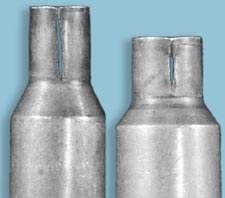Home | Glossary | Resources | Help | Contact Us | Course Map
Archival Notice
This is an archive page that is no longer being updated. It may contain outdated information and links may no longer function as originally intended.
Stress Relief, Annealing, and Hardness
Residual stress from the forming operations can affect both rimfire and centerfire cartridge cases. For many cases, especially those with bottlenecks, the stresses are so great that high-temperature annealing must be used.
After forming, a bottleneck case may appear perfectly serviceable. However, massive stresses are likely to remain in these areas. If the ammunition is loaded and stored without addressing these stresses, cracks can appear in the bottleneck area.
Case bottlenecks are normally flame-annealed by the following process:
- Placed on a moving rail or rotary disk system, the case passes before a set of gas burners that rapidly heat the neck and shoulder area to glowing.
- As the case becomes incandescent, the brass grains grow larger.
- The heated area of the case is immediately tipped into a water bath to quench the case, establishing the large grain size.
- The treatment causes a dark, but harmless, discoloration to the neck area. In commercial ammunition, this dark area may be polished out for cosmetic reasons; in U.S. military ammunition, the discoloration remains visible.
- The application of heat treatment technology to vary the grain size gradually, from small grains in the head area to large ones at the case mouth, determines case hardness.
All high pressure cases must have variable metallurgical properties depending on the part of the case, as follows:
- Head - must be tough and relatively unyielding, small brass grains contribute to the toughness.
- Body - the case walls must combine flexibility and strength to contribute to the obturation system.
- Mouth - must be softer (larger brass grains) to prevent cracks from the strain of holding a bullet.
Additional Online Courses
- What Every First Responding Officer Should Know About DNA Evidence
- Collecting DNA Evidence at Property Crime Scenes
- DNA – A Prosecutor’s Practice Notebook
- Crime Scene and DNA Basics
- Laboratory Safety Programs
- DNA Amplification
- Population Genetics and Statistics
- Non-STR DNA Markers: SNPs, Y-STRs, LCN and mtDNA
- Firearms Examiner Training
- Forensic DNA Education for Law Enforcement Decisionmakers
- What Every Investigator and Evidence Technician Should Know About DNA Evidence
- Principles of Forensic DNA for Officers of the Court
- Law 101: Legal Guide for the Forensic Expert
- Laboratory Orientation and Testing of Body Fluids and Tissues
- DNA Extraction and Quantitation
- STR Data Analysis and Interpretation
- Communication Skills, Report Writing, and Courtroom Testimony
- Español for Law Enforcement
- Amplified DNA Product Separation for Forensic Analysts



